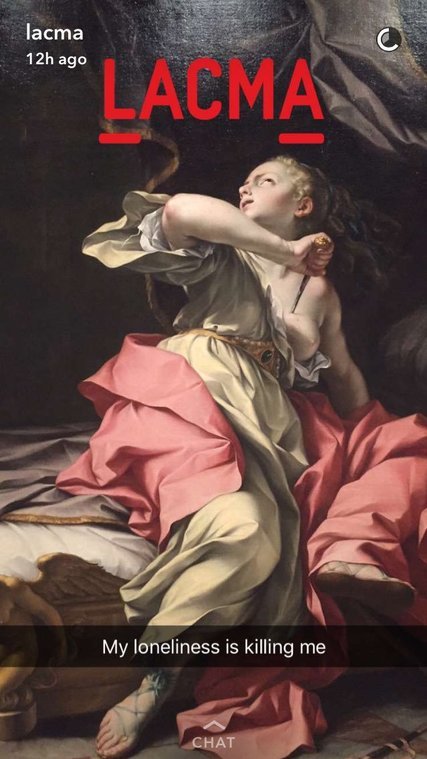Curation as Social Practice/ Museum as Discoursive Space
I will comment on the two articles along with several examples below:
As Christina Kreps mentioned, the increasing importance is placed on the educational role of the museum as a public institution. As we all noticed, social media has been a huge part of outreach and engagement as a tool of education. Take Los Angeles County Museum of Art as an example. LACMA has a collection including more than 130,000 objects dating from antiquity to the present. Curators snapped pictures, then coupled them with pithy one-liners for posting on Snapchat. For instance, the museum matched a photo of François Boucher’s 1742 canvas “Leda and the Swan” with the caption: “Stop looking at me, Swan,” from the ’90s film “Billy Madison.”
Social media managers in museums around the world have been reaching out to audiences via witty posts on all kinds of platforms. They’re delivering quirky, educated content to capture new audiences with innovative means. By using social media to seize and spread the imagination of younger audience, one museum can effectively take an educational role among audience.

As mentioned above, It is admitted that the new generation of museum users can take great advantage of social media, which somehow indicates that they can get their art preferences delivered instantly via social media and use technology for self-directed information-gathering. Thus the prospect of planning a trip to a museum can be daunting. What they expect is a new kind of museum experience. As pointed in Special Issue: Discursive Space, the new users expect to be empowered by museums to create an intriguing and meaningful experience by themselves. It is necessary to deliver an immersive experience that starts with the artistic object, performance, film or installation. Take Newseums as an example. The Newseum acquired eight segments of the monstrous walls and a three-story East German guard tower in 1993. Recently Newseum used virtual and augmented reality to model those historical objets and transport visitors to the streets where they originally were during the Cold War, allowing users to experience the divided city from the perspectives of suppressed Germans.

Although Those objects are important symbols of oppression and history, their identities might be gradually decontextualized as museum objects. By taking advantage of virtual reality technology, they are taken back to where they used to be and reconnected to their social context, which amplifying their social and cultural dimensions. Being placed in the original space virtually, the walls and guard tower are recontextualized again and create an immersive space for visitors. They are empowered to choose wherever they wander and whatever they get close look at.
As Jana Macalik articulate on discursive space, it should be a place of multiple, overlaid and sometimes conflicting voices – a place where historic dialogues can be rehearsed and reconfigured and where contemporary voices can be engaged and incorporated. A museum can be counted as a discursive space if it motivates people to be engaged with exchanging different opinions and shapes how they see things around them. The National Building Museum is a good instance. In 2015, the museum decided to Partner with Snarkitecture and hosted The BEACH. The visually compelling exhibit covered 10,000 square feet and included an “ocean” of nearly 1 million blue plastic balls and each translucent ball has a name of individual donors. This exhibition could give more people the experience of being wowed and transformed by what they encounter here, and see the world differently afterward, which enables the museum to be a container of thoughts and different voices.
